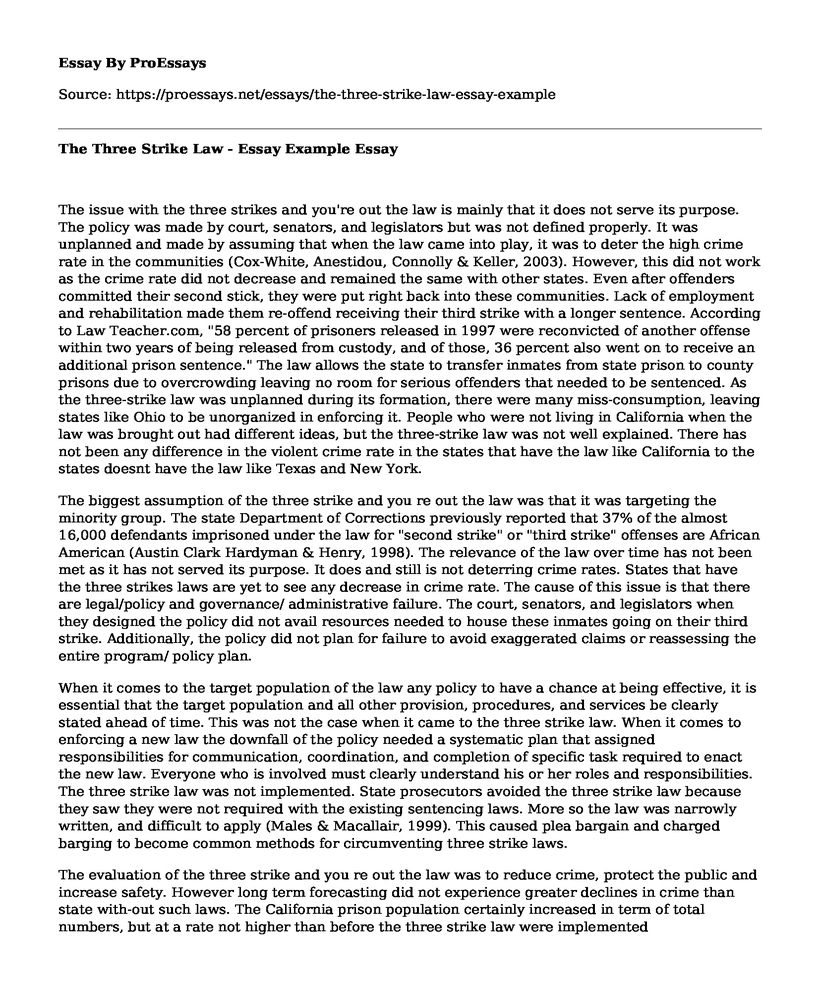The issue with the three strikes and you're out the law is mainly that it does not serve its purpose. The policy was made by court, senators, and legislators but was not defined properly. It was unplanned and made by assuming that when the law came into play, it was to deter the high crime rate in the communities (Cox-White, Anestidou, Connolly & Keller, 2003). However, this did not work as the crime rate did not decrease and remained the same with other states. Even after offenders committed their second stick, they were put right back into these communities. Lack of employment and rehabilitation made them re-offend receiving their third strike with a longer sentence. According to Law Teacher.com, "58 percent of prisoners released in 1997 were reconvicted of another offense within two years of being released from custody, and of those, 36 percent also went on to receive an additional prison sentence." The law allows the state to transfer inmates from state prison to county prisons due to overcrowding leaving no room for serious offenders that needed to be sentenced. As the three-strike law was unplanned during its formation, there were many miss-consumption, leaving states like Ohio to be unorganized in enforcing it. People who were not living in California when the law was brought out had different ideas, but the three-strike law was not well explained. There has not been any difference in the violent crime rate in the states that have the law like California to the states doesnt have the law like Texas and New York.
The biggest assumption of the three strike and you re out the law was that it was targeting the minority group. The state Department of Corrections previously reported that 37% of the almost 16,000 defendants imprisoned under the law for "second strike" or "third strike" offenses are African American (Austin Clark Hardyman & Henry, 1998). The relevance of the law over time has not been met as it has not served its purpose. It does and still is not deterring crime rates. States that have the three strikes laws are yet to see any decrease in crime rate. The cause of this issue is that there are legal/policy and governance/ administrative failure. The court, senators, and legislators when they designed the policy did not avail resources needed to house these inmates going on their third strike. Additionally, the policy did not plan for failure to avoid exaggerated claims or reassessing the entire program/ policy plan.
When it comes to the target population of the law any policy to have a chance at being effective, it is essential that the target population and all other provision, procedures, and services be clearly stated ahead of time. This was not the case when it came to the three strike law. When it comes to enforcing a new law the downfall of the policy needed a systematic plan that assigned responsibilities for communication, coordination, and completion of specific task required to enact the new law. Everyone who is involved must clearly understand his or her roles and responsibilities. The three strike law was not implemented. State prosecutors avoided the three strike law because they saw they were not required with the existing sentencing laws. More so the law was narrowly written, and difficult to apply (Males & Macallair, 1999). This caused plea bargain and charged barging to become common methods for circumventing three strike laws.
The evaluation of the three strike and you re out the law was to reduce crime, protect the public and increase safety. However long term forecasting did not experience greater declines in crime than state with-out such laws. The California prison population certainly increased in term of total numbers, but at a rate not higher than before the three strike law were implemented
References
Austin, J., Clark, J., Hardyman, P., & Henry, D. A. (1998). Three strikes and youre out: The implementation and impact of strike laws. Washington DC: National Institute of Justice-US Department of Justice.
Cox-White, B., Anestidou, L., Connolly, P., & Keller, D. R. (2003). The Three Strikes Law.
Males, M., & Macallair, D. (1999). Striking out: The failure of California's three strikes and you're out law. Stan. L. & Pol'y Rev., 11, 65.
Harris, Philip W. "Case StudyI.1 The Pitfalls of Poor Planning: Three-strikes Legislation." Criminal Justice Policy and Planning. By Wayne N. Welsh. 5th ed. New York,Ny: Routledge, 2016. 27-31. Print.
Cite this page
The Three Strike Law - Essay Example. (2021, Jun 16). Retrieved from https://proessays.net/essays/the-three-strike-law-essay-example
If you are the original author of this essay and no longer wish to have it published on the ProEssays website, please click below to request its removal:
- Essay Sample on Cyber Crimes by Cambridge Analytica
- Introducing an Enhanced Gynecology Service in Primary Healthcare Facilities in the UAE
- Essay Sample on Current Crime in South Africa
- Paper Example on Buyer-Seller Contract Dispute: Who Will Prevail?
- Essay Sample: Husband Kills Wife With Lou Gehrig's Disease in Chilling Way
- Paper Example on Courts Struggling to Modernize Punishment of Criminals
- Legalizing Marijuana in All States - Essay Sample







